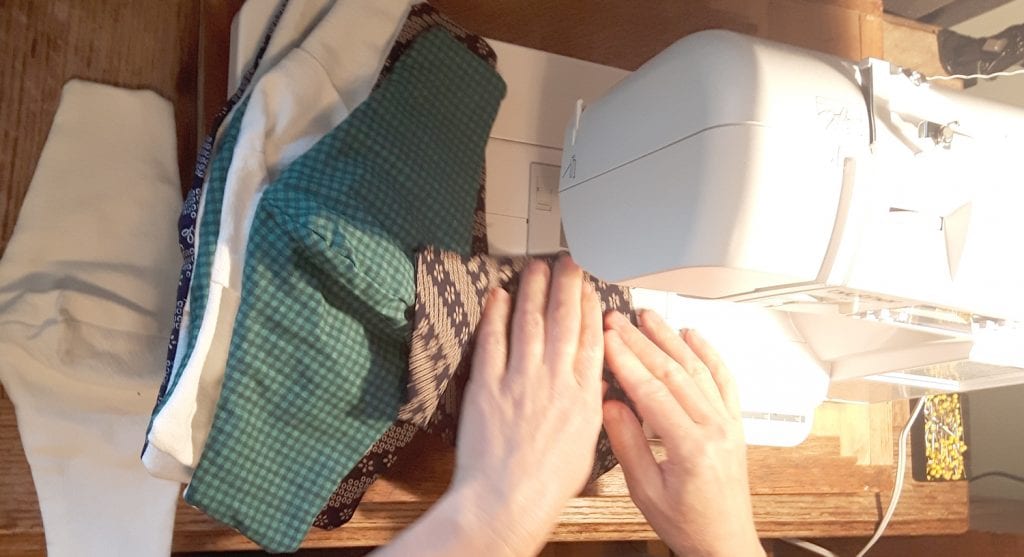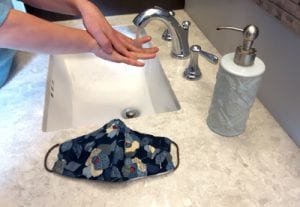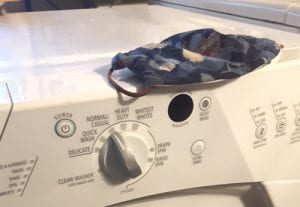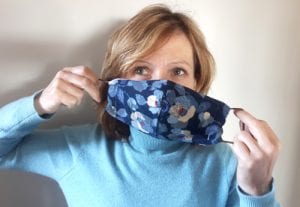
| MAKE+ has been getting questions about home sewn masks. In response, the research group applied their unique skills and methodology and compiled the following information to guide those wanting to sew masks for their own personal and family use.
Included below:
|
|
Introduction
 Masks are one tool in the toolkit that can assist in the prevention of the spread of a virus. They can help by catching the droplets from sneezes and coughs which can carry the virus.
Masks are one tool in the toolkit that can assist in the prevention of the spread of a virus. They can help by catching the droplets from sneezes and coughs which can carry the virus.
CDC recommends wearing cloth face coverings in public settings where other social distancing measures are difficult to maintain (e.g., grocery stores and pharmacies), especially in areas of significant community-based transmission.
Important:
- Masks do not prevent a person from catching a virus.
- Masks must be used together with other tools such as proper handwashing techniques and social distancing.
If you decide that making a mask is something you want to do for personal or family use, the links below can assist you in making an effective DIY mask.
Sewing a mask for personal or family use
Typically, medical grade masks must follow standards, and mask manufacture is regulated by government agencies. Home made masks cannot meet these standards. But as medical grade masks are being prioritized for medical workers, some guidance documents are now being created for home made masks.
Here are a few links that provide instruction on making masks:
- The CDC has instructions for 3 different masks including a no sew mask, a quick cut T-shirt face covering, and a no sew bandana face covering
- The MakerSpace at Unity Point St Luke’s Hospital (Ohio) developed a mask design based on their in-house research. Download the pattern
- The Deaconess Health System in Indiana (USA) developed a mask design that follows CDC protocols.
Save your ears!
Wearing a mask can be hard on one’s ears and innovators have developed a solution to protect your ears while wearing your mask.
Already made your own mask? Do a self-critique interim guidelines from the Minnesota Department of Health
 Putting on and taking off your mask
Putting on and taking off your mask
It doesn’t stop with making a mask, how you put on and take off a mask impacts how well it works. Not doing this right can increase the risk to you and others.
Wearing a mask
- You should not touch or adjust the mask.
- Always assume your hands and mask are dirty.
- If you do touch or adjust the mask, you need to immediately wash your hands.
Taking off your mask
- Before removing the mask – wash your hands first.
- Avoid touching the front of the mask when removing.
- If the mask has a tie at the back – slowly remove mask by untying the straps at the back.
- If the mask has straps behind each ear – slowly remove mask by pulling the strap from behind your ear.
- Place mask directly into washing machine, or into disposable bag.
- WASH HANDS AGAIN.
Two videos you might find helpful to learn about donning and doffing your mask can be found at:
- How to wear a surgical mask properly
Hong Kong Centre for Health Protection (CHP): Professional arm of the Department of Health for disease prevention and control. - Donning and doffing guidance for procedure masks
The Minnesota Department of Health is a State of Minnesota agency that operates programs for disease prevention and control, health promotion, family and community health, environmental health, health care policy, and regulation of health care providers and facilities.

Caring for your mask
Most home made masks can be washed in your home washing machine (with detergent) and dryer. If you are using a filter, the filter should be removed before washing and replaced with a new one each time the mask is used. You can learn more about how to wash and care for your masks by searching these websites.
More resources
The science
Here are some scientific publications on the effectiveness of masks (home made, surgical and N95:
- Rational use of face masks in the COVID-19 pandemic
- Mathematical modeling of the effectiveness of facemasks in reducing the spread of novel influenza A (H1N1)
- Professional and Home-Made Face Masks Reduce Exposure to Respiratory Infections among the General Population
- The use of masks and respirators to prevent transmission of influenza: a systematic review of the scientific evidence
- The First Randomized, Controlled Clinical Trial of Mask Use in Households to Prevent Respiratory Virus Transmission
- Face Mask Use and Control of Respiratory Virus Transmission in Households
- Surgical masks as good as respirators for flu and respiratory virus protection
Risks associated with the use of home made masks
Best sources for up to date information
Masks
There are a number of internationally respected sources of information on the use of personal protective equipment and masks that you should check regularly for updates on the current knowledge and guidance being provided.
- Health Canada
- Public Health Agency of Canada
- Centres for Disease Control and Prevention (CDC)
- World Health Organization (WHO)
- Minnesota Department of Health (search for Interim Guidance on Alternative Face Masks)
- Occupational Safety and Health Organization (OSHA)
Personal Protection
FAQ
What materials should I use to make my mask?
- most masks consist of 3 layers:
- Outer layer – this can be made from any readily available material, including tea towels, bedsheets, or Tshirts
- Middle layer- this is where you can include a replaceable filter for added protection. See below for more information.
- Inner layer – this layer should be breathable to minimize retention of moisture and facial heat – consider a dry wicking fabric
- consider using different fabrics on the inside and outside so you can tell which way to wear it
How do I put on and take off my mask?
- Use proper donning and doffing procedures- after you have used your mask you should treat it as though it contained the COVID virus on the outside. See putting on and taking off your mask.
- Do not wear your mask around your neck.
- Be sure to wash your hands thoroughly after touching your mask.
How can I tell if my mask fits properly?
- ensure the mask covers your nose and mouth, and goes under your chin
- ensure it stays in place during use (you don’t want to touch your mask once it is on)
- ensure there are no gaps along the side, around the nose or under the chin that would allow air and droplets
- your mask should have a shapable nose bridge that maintains its shape over time. It should not kink or break when adjusted.
How do I care for my mask?
- Be sure to wash and dry your mask after each use (your home washing machine and dryer are fine for this)
- If you are using a filter, the filter should be removed before washing and replaced with a new one each time the mask is used.
If I want to use a filter in my mask, what material should I use?
- you can include a replaceable filter in your mask for added protection. Consider a piece of pleated household furnace filter with a high MERV rating (a higher rating means it filters out more of the smaller particles), shop vac filter, or other vacuum bag paper cut to size . NOTE-if you are using a filter layer in your mask, do not pin or iron filter material as this may reduce its effectiveness
For more information please contact:
Principle Investigator, Centre for Rehabilitation Engineering and Technology that Enables (CREATE)
Project Leader, MAKE+
BCIT Centre for Applied Research and Innovation
This portal aims to give the reader information on:
- Scientific studies on the effectiveness of masks
- Things to consider in home made mask design
- Links to information from sites on how to make a mask
- Links to sites that show you the safest ways to fit, use, and put on/ take off a mask
- Links to Canadian guidance documents around the use of masks
- Official directives on mask use and personal protection during pandemics from other international sources

 Putting on and taking off your mask
Putting on and taking off your mask